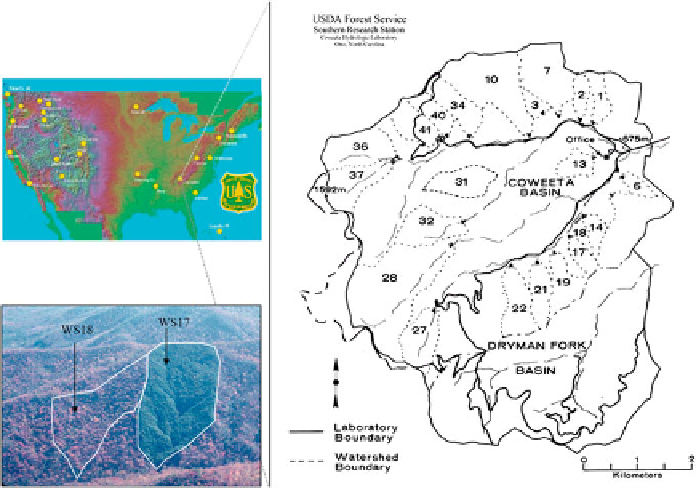Environmental Engineering Reference
In-Depth Information
Fig. 15.4 Location of the Coweeta Hydrologic Lab that is intensively instrumented for paired
watershed studies. Insert photos are to show typical watershed manipulation experiments. In this
case, a tree species conversion experiment used Watershed 18 as the control (deciduous forests)
and Watershed 17 as treatment (converted native deciduous to evergreen white pine forests)
experiments have been previously reported (Swank and Vose
1994
; Swank et al.
1988
,
2001
). Below is a synopsis of key findings in terms of forest influences on
water and micrometeorology at a small watersheds scale.
The climate of Coweeta is characterized as subtropical, marine climate with
moderate temperatures (13 C) and high abundant precipitation (1,800 mm/year at
low elevation but greater than 3,000 mm at high elevation). The parent rocks are
gneiss and schistorigins and weathered residual soil mantles are deep, up to 2 m at
foothills and 1 m on hillslopes. The region was heavily logged before 1923 and
hardwood trees (Oak-Hickory) dominate the second growth forests.
15.3.1 Micrometeorology
It is well known forests affect micro-meteorology such as humidity and radiation
redistribution (Swift
1972
). Clearing riparian forests increases radiation reaching
the forest floor thus elevate stream water temperature (Swift and Messer
1971
;
Swift
1973
,
1982
). Conifer forests (i.e., white pine plantations) have lower albedo
than deciduous hardwood forests (Swift et al.
1975
), thus more energy is available

Search WWH ::

Custom Search